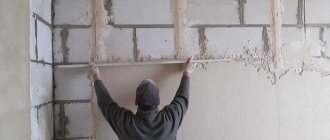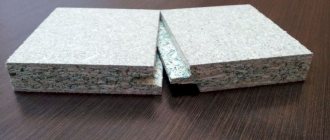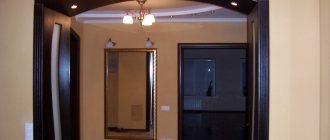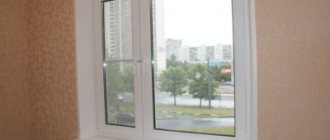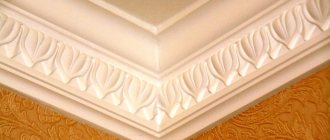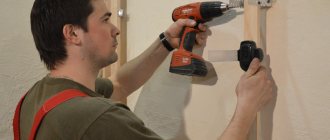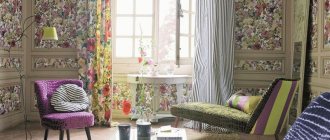Gypsum fiber sheet (GVL) is a finishing material with very attractive technical characteristics. It consists of 80% gypsum, 20% cellulose and, unlike conventional drywall, has a homogeneous structure without a shell. Let's find out how gypsum fiber sheets differ from plasterboard, what characteristics they should have according to GOST and what applications they can be used for.
Main parameters of GVL
GVL is a sheet finishing material with a rectangular configuration. Its technical characteristics and manufacturing technology are regulated by the requirements of GOST R 51829-2001. Both sides of the gypsum fiber sheet have a smooth sanded surface, treated with a water repellent and a special impregnation that prevents dusting of the material.
According to GOST, gypsum fiber sheet can have the following dimensions:
- length – 150, 200, 250, 270 or 300 cm;
- width – 50, 100 or 120 cm;
- thickness – 1, 1.25, 1.5, 1.8 or 2 cm.
Knauf, which has won first place in the Russian market among gypsum fiber manufacturers, produces products with the following parameters (size and weight):
Regular sheets:
- 250x120x1 cm, weight of one element - 36 kg;
- 250x120x1.25 cm, weight – 45 kg.
Elements for prefabricated dry floor screed (Knauf-superfloor):
- 120x 120x1 cm, weight – 17.5 kg;
- 120x120x2 cm, weight – 17.5 kg.
Based on their properties, gypsum fiber products are divided into two types:
- conventional (GVL);
- moisture resistant (GVLV).
Depending on the type of longitudinal edge, there are:
- sheets with straight edge (PC);
- GVL with folded edge (FC).
Don't skimp on quality
When purchasing gypsum fiber board sheets, we advise you to follow simple but effective rules. Buy products only from well-known manufacturers who have proven themselves well in the Russian market.
Even if their product is somewhat more expensive, we advise you not to waste time on trifles. Low quality gypsum fiber will cause you a lot of trouble and will not allow you to make repairs at a high level. You will most likely have to pay twice.
Pay attention to the markings of each sheet, since outwardly they are no different from ordinary plates.
Positive characteristics of GVL
The technical characteristics of gypsum fiber products are impressive:
- high density and strength (1250 kg/m³) – nails can be driven into gypsum fiber, it will not crumble;
- low thermal conductivity coefficient ensures effective thermal insulation of walls - the material is warm to the touch;
- good sound insulation - from 35 to 40 dB, depending on thickness;
- excellent fire resistance - GVL can be used to protect wooden structures and communications from fire in case of fire;
- frost resistance - the material can be used for finishing walls, floors and ceilings in unheated rooms, for example, on a balcony;
- moisture resistance - refers to GVLV, ordinary gypsum fiber material is hygroscopic - it can accumulate and release moisture, but does not deteriorate like drywall.
USEFUL INFORMATION: Which sanding machine should I choose?
The positive characteristics of gypsum fiber board also include the absolute environmental friendliness of the material and ease of processing and installation.
Features of the material
The basis for its production can be called gypsum, to which cellulose fibers made from waste paper are necessarily added, and their percentage ranges from 15 to 20%, and they also play the role of reinforcing substances. Externally, such sheets are very similar to plasterboard sheets, but such material does not have paper on the surface.
But this material has higher performance properties. The shelf life of such boards is much longer, and the qualities of moisture-resistant sheets make it possible to install them in rooms where there is a high level of humidity.
This is an extremely popular building material that has gained good fame recently, and it is used for interior and exterior decoration. It is made from a couple of layers of cardboard paper, used in the construction industry, as well as a core, which contains a hardened gypsum-water mixture, as well as certain fillers that give the mixture the desired beneficial qualities.
This material was first invented in the United States in the 19th century, and the inventor was Augustine Sackett, the owner of a large pulp mill. But after a while, the new composition, as well as the dimensions of the plasterboard sheets, were patented by Clarence Utsman, the best American engineer. Now the standard dimensions of sheets are measured in the range from 0.6 to 1.2 meters. The material is used indoors with humid and dry climates. The modern composition is 6% paper cardboard, 92% gypsum, and the remaining 2% is starch, water and other organic substances.
Appearance and marking of gypsum fiber sheets
Unlike drywall, which differs in color depending on its properties, gypsum plasterboard sheets have the same white-gray color. Each sheet has a marking applied in accordance with GOST in blue on the reverse side. There are no special markings; on a gypsum fiber moisture-resistant sheet with a straight edge it will be written:
GVLV-PK-2500x1200x10 GOST R 51829-2001 (size is indicated in mm).
In accordance with GOST, high-quality material should not have oil stains, damage to the front surface, ends and corners.
What it is?
GVLV is a finishing sheet material, it is a rectangle. It is made on the basis of gypsum and contains cellulose for strengthening (reinforcement) and many additives. That is why gypsum fiber sheet is stronger than plasterboard, and thanks to additional additives, GVLV has increased moisture resistance and fire resistance. The material is environmentally friendly - this is its main advantage. It is divided into two types - simple GVL and moisture-resistant (GVLV). In terms of structure, gypsum fiber differs from gypsum plasterboard in that it does not have cardboard as an outer shell. During its manufacture, cellulose fibers are added and monolithic sheets are pressed. These fibers add reinforcing properties to the material, making it strong and durable. GVLV has increased sound and heat insulation.
Such sheets are moisture resistant and have a sound insulation function.
Scope of application of gypsum fiber
Knauf gypsum fiber sheets are successfully used for finishing walls in residential premises, as well as for the construction and finishing of public and industrial buildings. Gypsum fiber is used for the construction of interior partitions and walls in apartments; it is possible to use a waterproof type of gypsum fiber board in rooms with high humidity, such as a bathroom, followed by tiling.
Sheathing of frame structures, such as partitions, wall cladding, suspended ceilings, involves the use of gypsum fiber board with a seam edge.
As a separate area of application, we can mention the use of GVL for the construction of a rough floor covering - dry floor screed using Knauf technology. To create such a floor, so-called Knauf supersheets are used, which have a straight longitudinal edge.
Due to its high fire resistance, it is possible to use GVL for fire protection of load-bearing structures, wooden elements, and cable ducts. The environmental friendliness of the material allows it to be used for finishing the ceiling, floor and walls in any living room, including the bedroom and children's room.
USEFUL INFORMATION: The screed will correct all uneven floors
Existing varieties
GVL slabs for walls have a straight edge. They can be used for leveling - standard and moisture resistant.
Under alignment
Standard GVL slab for leveling: it is used for cladding rooms where the humidity is normal.
Pros: durable, fireproof and moisture resistant.
The finished material is produced in rectangular slabs with the following parameters:
- length 2.500;
- width 1.200;
- thickness 10 or/and 12.5 mm.
Moisture resistant
The moisture-resistant GVL board is particularly resistant to moisture, thanks to the composition with which it is treated. It is used for covering rooms where the humidity is higher than the corresponding norm. The standard parameters are the same as for leveling plates. They also produce small format ones: 1200x1200x10.
Differences between GVL and GKL
Despite their similar composition, gypsum fiber and plasterboard sheets have different structures, which determines the difference in the technical and operational characteristics of these finishing materials:
- The homogeneous structure of gypsum fiber ensures an even cut without chipping, while plasterboard can crumble at the cut points. In this regard, gypsum boards are usually used in solid pieces, but gypsum fiber can be cut into elements of any size.
- The use of GVL instead of GCR is advisable in places where increased resistance to shock and damage is required.
- Drywall has high plasticity, which allows you to create a variety of structures of any shape, while gypsum fiber breaks when strongly bent.
- GKL and GVL differ in their level of frost resistance. Drywall can withstand only 4 cycles of freezing and thawing, after which cracks appear on it, gypsum fiber can withstand 15 cycles.
- The fire resistance of gypsum fiber is much higher than that of plasterboard.
- The materials have a difference in price - ordinary drywall is 2 times cheaper than a gypsum fiber sheet of the same thickness.
For comparison, here is a table of approximate prices for different types of gypsum fiber boards and gypsum boards from KNAUF:
Frame
Installation of gypsum fiber boards can be done in two main ways - frame and frameless. In the first case, a frame is pre-constructed onto which the slabs are subsequently fixed. In the second, the slabs are glued directly to the wall surface using special glue.
The best material for creating a frame for false walls is a metal profile.
Work is carried out in the following sequence:
- Marking the room - using special tools, marks are made on the surface along which the frame will be mounted in the future.
- Installation of the starting profile involves mounting a frame around the perimeter of the room. For this purpose, anchors with sleeves made of plastic or metal are used. They are screwed into pre-drilled holes with a depth of 40 mm. In areas where the profile adjoins the main structures, a sealant is applied.
- Installation of the post opening begins with the doorway, its edges are mounted from two-post elements built exactly into each other. All necessary parts must be fixed with wooden blocks. The jumper is made from a profile for racks, bent in a U-shape.
- Formation of vertical posts - they are inserted into the starting profile from above and below, the pitch is calculated so that the edges of the gypsum fiber board fall exactly on the center of the guide when sheathing. The main thing is that the gypsum fiber sheets are placed on both sides of the partition being formed with a slight offset of the joints.
When installing the frame, do not forget to think about communications; for this purpose, special holes are made in the racks for cables and electrical wires.
Covering a frame with panels is a rather labor-intensive job that requires effort and time:
- The gypsum plasterboard sheet is cut so that when joining the slabs there is a gap of at least 5 mm. If this rule is not followed, deformations may occur in the future.
- The trimmed sheet of gypsum fiber is applied to the frame and leveled. If its edge “sags,” an additional metal jumper is inserted into the structure.
- The plate is fixed using self-tapping screws; screws should be 4 cm long and tightened in increments of 30 cm.
The structure of gypsum fiber is porous, this often causes uneven application of paint or glue during further finishing of the gypsum fiber surface. That is why you should carefully putty the surfaces of the entire area of the slabs. To do this, you can use the most common gypsum putty. Only after this the wall becomes suitable for any type of finishing materials.
Lifetime
Gypsum fiber has optimal durability and fire resistance. With proper installation and care, the material will last for many decades.
Silicate paint and putty, as well as materials based on liquid glass, should not be applied to gypsum fiber sheets.
GVL is a practical and sustainable finishing material with many advantages. Suitable for both exterior and interior decoration. Follow the recommendations and fastening rules, then it will meet all the stated advantages. Provides high-quality sound insulation.
Finishing
- How to reinforce seams?
Traditionally, serpyanka (self-adhesive fiberglass mesh) is used for this purpose. It is glued over the seam, after which it is filled with putty directly through the cells in the mesh. The second layer of putty is applied after the first one has set and covers the reinforcing material, hiding its texture.
Seam reinforcement with serpyanka.
I preferred to reinforce the seams with rolled fiberglass. It is glued to PVA glue diluted with water after filling the seam and covered with another layer of putty. Fiberglass is thinner than serpyanka, so the seam stands out less on the surface of the sheet.
- How to paint walls made of plasterboard and gypsum board?
Any water-dispersion paint. I used acrylic and latex based water emulsions. In the bathroom, the gypsum plasterboard walls are painted with rubber waterproofing paint. It is impervious to water, tolerates wet cleaning well and is resistant to any cleaning agents (except, of course, abrasive ones).
I used rubber paint made in Sevastopol. The impressions are purely positive.
- How to lay tiles on GVL and drywall?
You can use regular cement tile adhesive. In addition, I have used stone flour mastic and silicone sealant at various times. In both cases, the tile was held absolutely securely; Moreover, I have a strong suspicion that it will only be possible to remove it with a fragment of the wall.
A tiled apron mounted on silicone and rubber paint on the walls of the bathroom.
- How to install a shelf or cabinet on a wall made of gypsum board or gypsum board?
When installing the frame, place a board or timber in it and attach hanging furniture to it. With the same success, you can glue an embedded part made of thick plywood to the back of the drywall. Finally, you can use the Molly anchor to install lightweight shelves and cabinets.
Wooden insert for a kitchen cabinet.
Anchor Molly.
